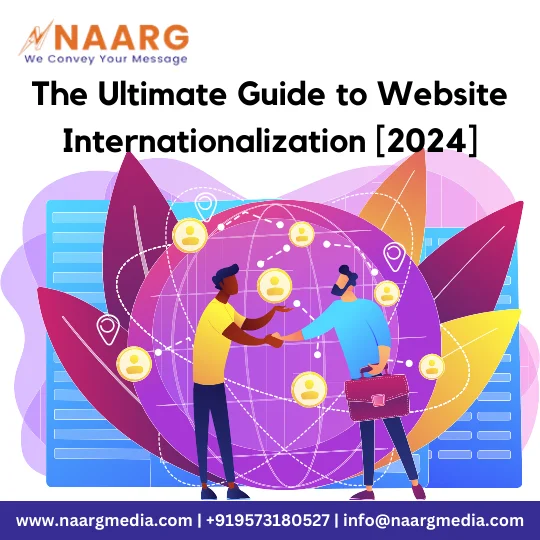All thanks to globalization and the growing use of the internet, every one of us is connected in ways that you could not have imagined 20 years ago. But here, we are connected with more people than ever before. But when it comes to business point of view, for any business trying to expand anywhere in the world. A challenge comes along with reaching your audience in multiple languages and catching their attention.
For this, you need website internationalization to succeed in the target market. But what is website internationalization? It is the process of making sure your website is capable of supporting and is configured to handle multiple languages. It ensures your website gets equipped to provide an optimized user experience for a specific target location.
This blog post delves into the intricacies of website internationalization, how to internationalize a website, and future trends.
So, let’s get started.

Importance of Website Internationalization
The success of your business depends on the internationalization and localization of your website if you wish to reach audiences worldwide. As you know, according to CSA research, 40% of consumers won’t engage with a business if it is not in their native language. Website internationalization has become crucial in today’s globalized landscape because of its ability to expand your business and reach and connect with diverse audiences.
Adopting internationalization practices includes multilingual website content, a localized user interface, and region-specific cultural considerations. Once internationalized, your website can effectively cater to the preferences and expectations of your users from different cultural and linguistic backgrounds. It will not only enhance the user experience but will also foster a sense of inclusivity, making our website more accessible to a broader audience.
Moreover, internationalization in practice is instrumental in breaking down language barriers and facilitating cross-border transactions, hence establishing a stronger presence. Once your business prioritizes website internationalization, it will not only demonstrate a commitment to global engagement, but you will position yourself for increased competitiveness in the international market. In essence, internationalizing your website is not just a technical consideration but a strategic imperative for your business.
How to Internationalize a website?
Website internationalization involves many steps. Here are some steps to effectively internationalize your website:
1. Language Support
For internationalizing a website, first, implement a multilingual content strategy to accommodate users from different cultural and linguistic backgrounds. Ensure the use of tags in the HTML to signal the language of a page to assist search engines in indexing.
2. Localized Content
When internalizing a website, provide region-specific content, considering cultural nuances, preferences, and sensitivities. Always tailor images, videos, and other elements to make your website culturally relevant.
3. User Interface Localization
Translate your user interface elements, like buttons, menus, and forms, into the native language of the target audience. Also, consider the layout adjustments for languages with different reading directions, like some languages that are left-aligned to enhance readability.
4. International SEO
Make sure to optimize content for international search engines by conducting keyword research in multiple languages. Also, implement hreflang tags to indicate regional and language targeting.
5. Geotargeting
You can use geotargeting to automatically direct your users to the most relevant version of your website based on the location of your audience. And allow your users to manually select their preferred region if needed.
6. User Feedback
Once your website is internationalized, encourage feedback from your users to identify and address any issues or improvements needed for your multilingual website.
By following all these steps, you can create a more inclusive and user-friendly online presence for your business. Enabling you to communicate with a wide range of international audiences.
Future Trends in Website Internationalization
Future trends in website internationalization involve considering user expectations, technological advancements, and global market dynamics. Some potential future trends in website internationalization include:
1. AI-Powered Localization
Artificial intelligence integration for more efficient and context-aware localization will be in style. AI algorithms will analyze cultural context, user behavior, and preferences to dynamically adapt your content. Many automation tools, including machine translation and localization platforms, are expected to become more sophisticated. Also, advances in natural language processing will lead to more accurate translations, reducing the manual effort required for localization.
2. Multilingual SEO
Search engines will become more advanced, so optimizing your websites for multiple languages and regions will be crucial. Websites have to implement SEO strategies that consider language nuances and search engine algorithms specific to each target audience.
3. Personalization
Websites will focus more on providing personalized experiences for users across different regions. It involves tailoring your content and user interfaces based on local trends and your consumer’s behavior.
4. Voice Search Localization
As you know, there is a growing popularity of voice-activated devices and voice search, so website internationalization will need to adapt to accommodate different languages and accents. For voice interfaces, accurate language processing and localization will be required to provide a seamless user experience globally.
5. Real-Time Content Updates
Dynamic content delivery and real-time content updates based on user location, behaviors, and preferences will become more common. The content management system will see an increase due to increased demand for localized content. It will ensure your users receive the most up-to-date and relevant information based on their context.
Staying abreast and current with these trends will be essential for businesses and web developers aiming to create a seamless and inclusive experience for all users worldwide.
We are Naarg, a global language services provider that supports various businesses in reaching a global audience in any language. Naarg Media is a proven translation service provider, providing support to all clients with the best results in various domains. We at Naarg strive to provide professional translation and localization services to all our clients across the globe.
Contact us today to learn more about our translation and localization services.

